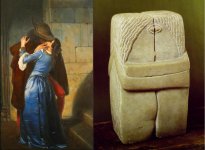There was a thread about whether Dali or Picasso were the better? And it got shut down? A moderator here a Jeff Koons fanatic?
What makes for a great work of art? It varies. If you're a high end collector, gallery, or corporation, a great work of art is one that can be used to provide a hefty tax shelter, or a woodie, maybe both.
Other than that, I'd have to say that a great work of art is one that communicates with the beholder. The nature of that communication varies with the individual's sensibilities, be it spiritual, emotional, intellectual, sensual, sexual, or whatever floats one's boat, expanding that individual's life experience through the encounter, sometimes to a profound extent.
What makes for a great work of art? It varies. If you're a high end collector, gallery, or corporation, a great work of art is one that can be used to provide a hefty tax shelter, or a woodie, maybe both.
Other than that, I'd have to say that a great work of art is one that communicates with the beholder. The nature of that communication varies with the individual's sensibilities, be it spiritual, emotional, intellectual, sensual, sexual, or whatever floats one's boat, expanding that individual's life experience through the encounter, sometimes to a profound extent.









